Garden Season Extenders
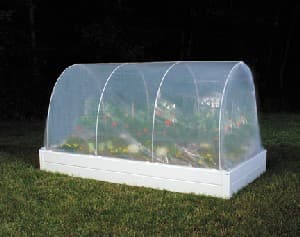
Season Extenders to Garden Earlier in Spring, Later in Fall
Season Extenders are wonderful gardening tools. They allow gardeners to enjoy their hobby a month or two longer, spring and fall. In the spring, gardeners are chomping at the bit to get out into the garden and plant something, anything. Every gardener’s late winter dream is to get a jump on the season. Also, Jack Frost sometimes visits the garden before our final crops are ready to harvest. Certainly, a true gardener can’t allow something like a little frost to ruin those final roses or keep those pumpkins from ripening.
Enter the world of gardening season extenders. Use them to warm up the soil in the spring. Also, season extenders protect plants from frost in spring and fall. They can be anything from a simple piece of plastic or an old blanket thrown on the tomato plants on a frosty fall evening, to a walk-in greenhouse that allows you to start gardening a couple of months before anyone else in the ‘hood. So, let’s explore them all………
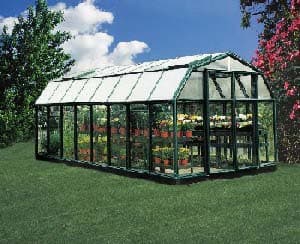
Greenhouses are the Ultimate Season Extender
Avid gardeners find greenhouses are a perfect solution. Greenhouses come in a wide range of styles to fit your needs and budget.
Basic types are:
Walk-in, permanently placed – These look superb in the backyard. They are every avid gardener’s dream. Permanent greenhouses have venting systems and optional heating systems, to allow you to use the greenhouse 2-3 months longer, in both spring and fall. Also, many areas can use them year-round.
Walk-in, movable – Portable Portable greenhouses are growing in popularity. They are less expensive than a permanent greenhouse. In addition, they fold up easily (or are disassembled quickly) and stored away when not in use.
Hobby Greenhouse Systems – These greenhouses consist of a raised bed and a fitted, latched cover system. Your garden season begins a month or so before the last frost and extends fall gardening. Second, it’s easy to put on or take off the cover system. They are perfect for small areas, limited budgets, and people who don’t want a big walk-in greenhouse. Attractive in appearance, they scream “an avid gardener lives here” to friends and neighbors.
Hoop House – A hoop house is easy to make. First, anchor PVC tubing to the ground to form a half-circle. Then, cover (sides and ends) the tubing with plastic sheeting, securing it well. It makes for a great temporary greenhouse and is inexpensive. Plastic sheeting usually requires frequent replacement. It’s not as attractive as other options and is mostly used on farms.
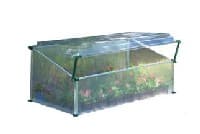
Cold Frames are Spring Early Season Extenders
Cold frames are really popular for a much earlier start on the season. They keep tender, young seedlings cozy warm. In addition, they provide more sunlight than they get indoors. Cold Frames are also used to “harden off” indoor transplants”.
In some areas, they are used to overwinter container-bound plants and shrubs.
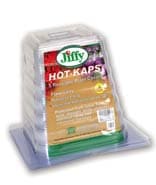
Hot Kaps are Great Season Extenders
Hot Caps, or “Hot Kaps” (also spelled: hotcap or hotkap) protect young seedlings from frost. They are quickly placed over tender annuals when frosts or cold evenings are in the forecast. Hot Kaps must be removed in the morning, before sunlight raises temperatures inside the hot cap to levels dangerous. While they are inexpensive, they protect against frost, not extended periods of freezing weather. The plants often quickly outgrow the size of the hot caps.
Tip: Make sure hot caps are stackable, so they can be stored in a small space for next year’s use.
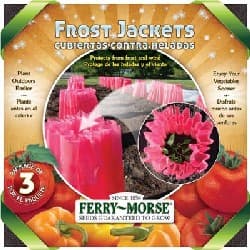
Frost Jackets for Early Spring Planting
Prost Jackets are used weeks before the last spring frost. This group includes Frost Jackets and Wall O’Water, also called a “Garden Tepee”. A Frost Jacket is part hot cap, part miniature greenhouse. Set a Frost Jacket around a plant and fill it with water. It absorbs heat from the sun during the day and releases it at night. It can stay around the plant all season long or be removed after the last spring frost. Frost jackets are more effective warmers than hot kaps, allowing an even earlier start. As a result, frost jackets are a great way to get a jump on the season.
An unexpected frost catch you off-guard? Something as simple as a large plastic drinking cup can be placed over small tomato or pepper seedling. If the plant is too big, try a five-gallon bucket!
Clotche
Need to protect a long row of plants from a late frost? Or, do you want to start a row of vegetables a couple of weeks early? A cloche may be the answer. A cloche is a mini “Hoop House”, standing one to three feet high at the center of the row. A series of tubing, usually PVC, is hooped every couple of feet along the row. Plastic sheeting is placed over the hoops. The ends are covered during cold weather and uncovered on warm days. It offers inexpensive frost protection and allows a few weeks’ head start for your plants. It is removed as warm weather arrives.
Cloches are popular around the world for early starts of a variety of vegetables and tender annuals.
For a Quick Coverup, Use these Season Extenders
When frost is in the forecast, just about anything will do for a quick cover up. The object is to cover your plants, so moisture in the air does not form on the plant’s leaves and freeze as the temperatures drop to 32 degrees or below.
For covering large areas try:
- Plastic sheets
- Bed sheet
- Blanket
- Tarp
These items are lightweight, as you don’t want to crush the plant’s leaves. Commercially, you can buy inexpensive row covers. These items are commonly used in the fall to extend the season beyond the first killing frost. A little effort can be very “fruitful” as vegetable prices rise at local stores as soon as the first frost hits.
Tip: Light-weight cover-ups need to be anchored to keep the wind from blowing them off your plants.
Please support our site. Shop for:
- rmmatthews100@hotmail.com
- 585-721-6528
- Rochester, NY
©1999-2024 GardenersNet.Com, All Rights Reserved

